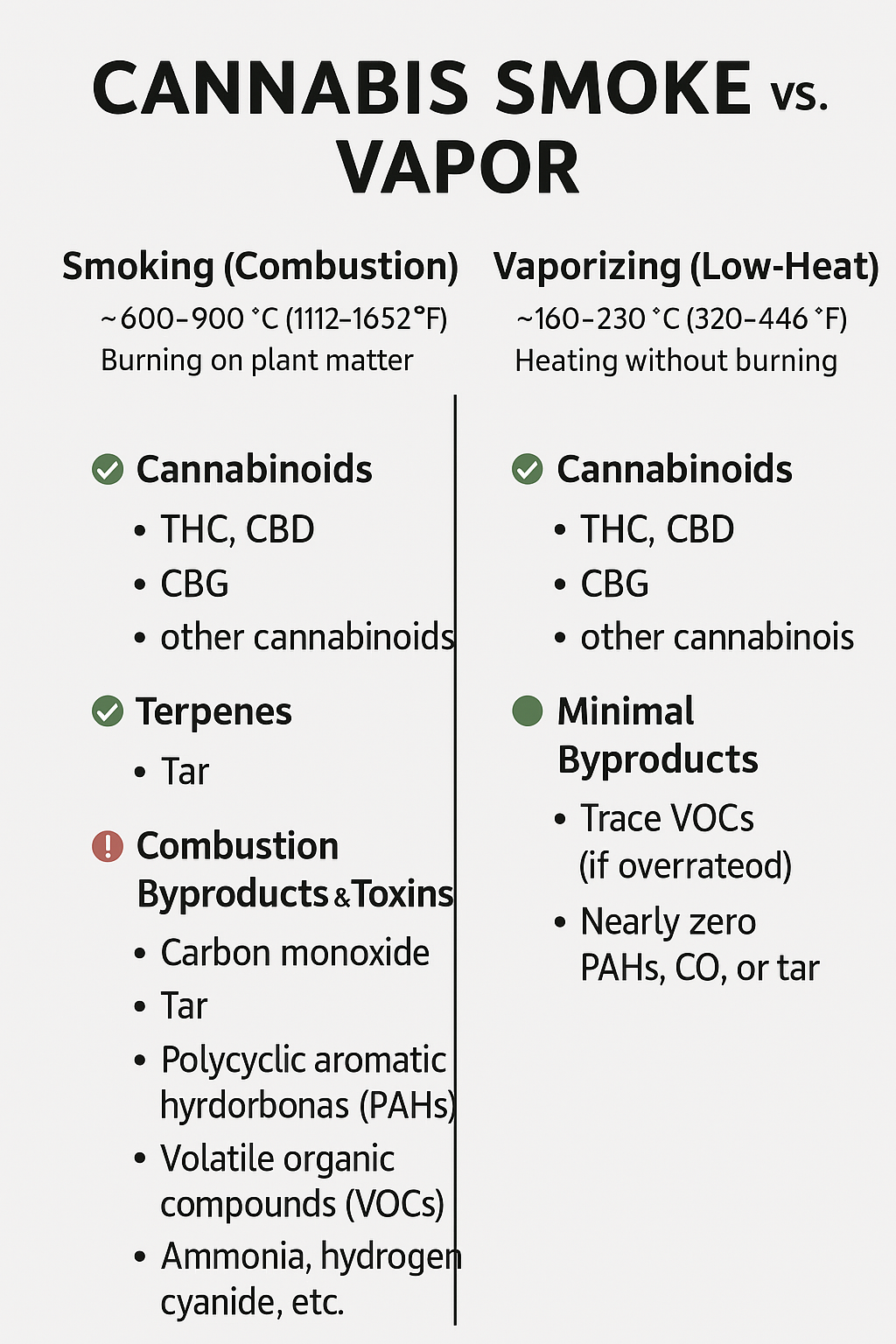
Cannabis Smoke vs. Cannabis Vapor: A Chemical Comparison
How cannabis is consumed significantly affects what enters the body. Two common inhalation methods — smoking (combustion) and vaporizing (heating without burning) — produce different chemical profiles. While both deliver cannabinoids and terpenes, their thermal dynamics result in vastly different toxins, byproducts, and health implications.
Temperature Differences
| Method | Temperature Range | Key Outcome |
|---|---|---|
| Combustion | ~600–900°C (1112–1652°F) | Burns plant matter; produces smoke, ash, and toxic byproducts |
| Vaporization | ~160–230°C (320–446°F) | Heats cannabinoids/terpenes to release vapor without burning |
What’s in Cannabis Smoke?
Combustion releases a complex mixture of over 1000 compounds, many of which are byproducts of burning organic matter. According to multiple studies (notably from the California NORML/MAPS vaporizer study and Health Canada reports), cannabis smoke contains:
Desirable Compounds
-
THC, CBD, CBG, and other cannabinoids
-
Terpenes (though many are destroyed at high temps)
Combustion Byproducts & Toxins
-
Carbon monoxide (CO) – Reduces oxygen in the bloodstream
-
Tar – A sticky residue containing many harmful chemicals
-
Polycyclic aromatic hydrocarbons (PAHs) – Linked to cancer
-
Volatile organic compounds (VOCs) – Including benzene, toluene, and formaldehyde
-
Ammonia, hydrogen cyanide, nitric oxide – Found in tobacco smoke as well
-
Acrylamide and acrolein – Respiratory irritants and potential carcinogens
Up to 88% of smoke particles by weight are non-cannabinoid combustion products【source: Health Canada, 2001】.
What’s in Cannabis Vapor?
Vaporizing cannabis heats the material below combustion temperatures, releasing volatile cannabinoids and terpenes into a gas without burning plant matter. The result is a cleaner inhalation with drastically fewer harmful byproducts.
Desirable Compounds
-
Cannabinoids (THC, CBD, CBG, etc.)
-
Terpenes (linalool, limonene, myrcene, etc.)
-
Flavonoids and minor phytochemicals (depending on temp)
Minimal Byproducts
-
Trace VOCs (if overheated or if plant matter is scorched)
-
Nearly zero PAHs, CO, or tar
-
Far lower concentrations of harmful gases (e.g., ammonia levels 20x lower than in smoke)
Key Study:
-
NORML/MAPS 2004 study found that vapor from a Volcano vaporizer consisted of 95% cannabinoids and minimal toxins, while smoke contained significant amounts of pyrolytic compounds.
Comparative Summary Table
| Component | Smoking (Combustion) | Vaporizing (Low-Heat) |
|---|---|---|
| THC/Cannabinoid Delivery | Moderate–High (some destroyed) | High efficiency (~50–80%) |
| Terpene Preservation | Low (many are burned) | High (temp-sensitive profiles maintained) |
| Carbon Monoxide (CO) | High | Minimal–None |
| Tar | High | None |
| PAHs | Present (multiple types) | Virtually absent |
| VOCs (e.g., benzene) | High | Trace (if overheated) |
| Ammonia | High | ~20x lower than smoke |
| Respiratory Irritants | Common | Significantly reduced |
Health Implications
| Health Impact | Smoking | Vaporizing |
|---|---|---|
| Lung Irritation | Common (due to tar, CO) | Mild (less harmful residue) |
| Cancer Risk (long-term) | Elevated (from PAHs, VOCs) | Significantly reduced |
| Taste & Aroma | Harsh, burnt | Clean, flavorful |
| Smell/Residual Odor | Lingering smoke smell | Minimal and dissipates fast |
| Efficiency | Lower (cannabinoid loss) | Higher retention |
Conclusion
Vaporization offers a cleaner, more efficient, and significantly less harmful way to consume cannabis than combustion. While both methods deliver active cannabinoids, vaporizing avoids the toxins associated with burning plant material — making it the preferred method for health-conscious users, patients, and anyone seeking better control over their cannabis experience.
- Choosing a selection results in a full page refresh.

